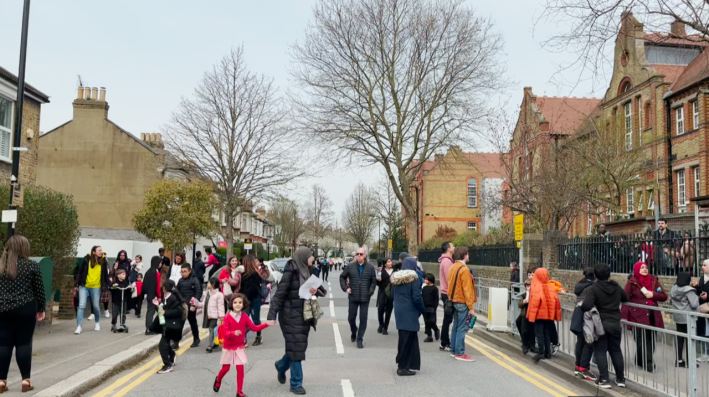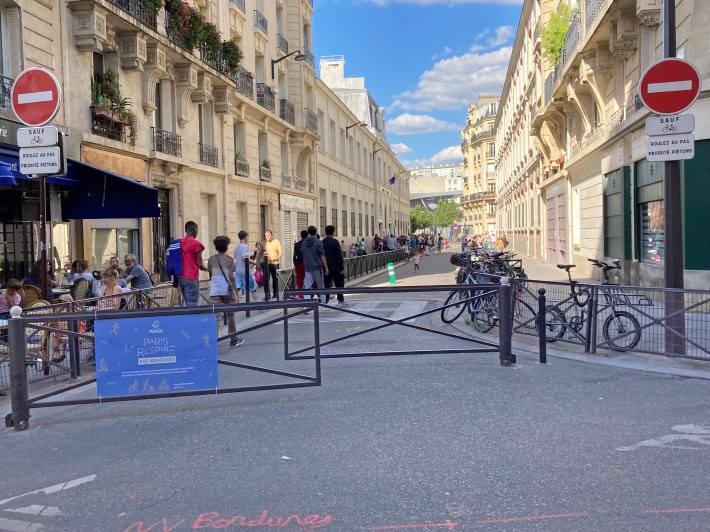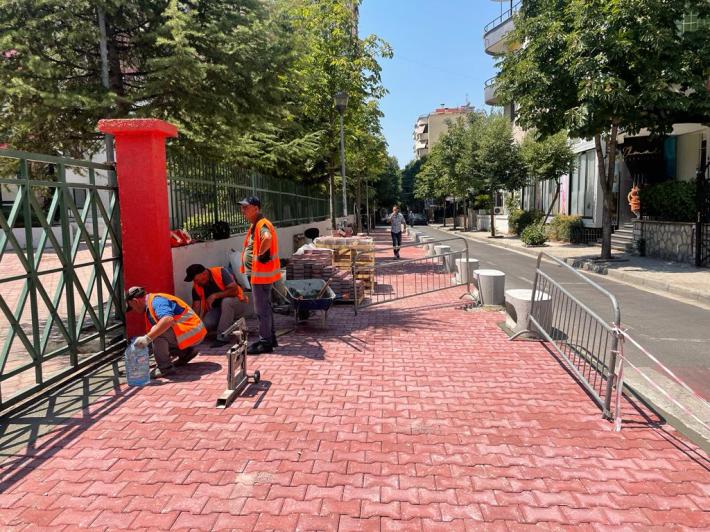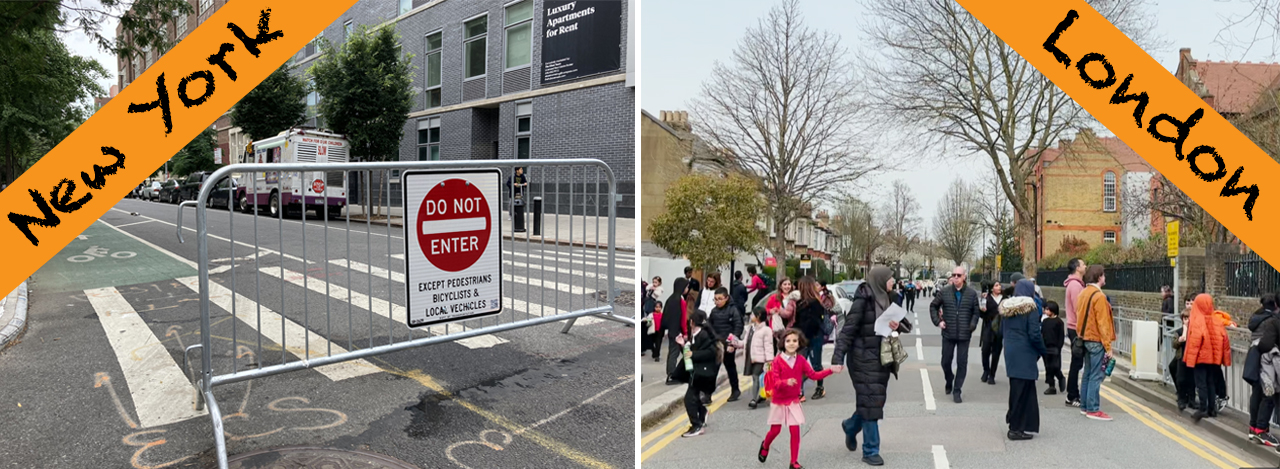A movement to ban cars from streets near schools is taking off around the globe, with cities from Vancouver to Auckland now maintaining more than 1,200 car-free zones on streets outside schools to protect children from traffic and air pollution.
One place that isn’t leading the charge? New York City.
The greatest city in the world is trailing far behind its global counterparts in safeguarding some of its most vulnerable residents in the public realm. London now has more than 500 so-called “school streets,” most installed in just the past few years. That’s one for roughly every 18,000 residents. Paris has more than 160 school streets, or one for every 13,000 residents.
Smaller cities have also gotten in on the game, including Tirana, the capital of Albania, which has built one school street for every 85,000 residents.
As for New York? By mid-June, the city had just 41 school streets serving 38 schools, or one for every 207,000 residents.
To explain the difference, school streets boosters pointed to the strong support the projects have received from elected leaders elsewhere. Officials in cities like London and Paris have publicly made the case for pedestrianizing the spaces, arguing that the projects reduce car crashes and air pollution outside schools, promote active lifestyles, foster community, and make their cities more pleasant places to be. They’ve also devoted millions of Euros to building school streets.
The investment is paying off. In London, surveys found the projects are popular, traffic is down and air quality is up. More school streets are on the way.
And then there’s New York. After an initial push for car-free space outside schools earlier in the pandemic, school streets are all but absent from the agendas of Mayor Adams and the City Council. The city provides no funding to schools participating in its anemic school streets program, which now consists disproportionately of wealthy private schools, Streetsblog reported last month.
It’s not for a lack of need. On school days, streets near schools in New York City are far more dangerous than other city streets, with much higher rates of car crashes and injuries, Streetsblog reported in May. Drivers have killed at least 24 children walking or biking to or from school in the city in the past decade.
That, too, is a far cry from the situation in cities that prioritize the issue.
“If it happened in Paris, we would have had people marching and protesting outside in the street,” said Tony Renucci of the 24 children killed in New York. Renucci is the director general of Respire, a French air quality advocacy group involved in Paris’s school streets program.
How have other cities accomplished what New York has not? Read on.
London

In 2019, London had fewer than 90 school streets. Now it has at least 511. By next year it plans to build 80 more.
As in New York, school streets’ initial appeal in the U.K. capital lay in the social distancing they enabled as children resumed in-person learning before COVID-19 vaccines became available. But Transport for London, the city’s unified transportation and transit agency, saw the rare opportunity the pandemic presented to reclaim large swaths of the city from cars, and officials sized on it.
“School Streets as emergency measures are intended to be rolled out rapidly, to help schools facilitate social distancing and to reduce the risk of a car-based recovery from coronavirus,” Transport for London wrote in its school streets guide (emphasis ours). “Formal consultation does not need to be undertaken prior to implementing a School Street.”
It made things easier that there was real money behind the project. By late 2020, the city had already devoted £4.3 million ($5.2 million) to building school streets.
Unlike New York’s program, which schools must voluntarily join, the road redesigns in at least one London neighborhood happened by default.
“Unless the school opted out, we would install school streets at all suitable locations” reads a school streets guide produced by Hackney, the London borough that has been especially active on the issue.
Instead of thin metal barriers seen at the ends of New York school streets, London often uses cameras to enforce the restrictions. Posted signs indicate the hours when cars are prohibited–usually during narrow drop-off and pick-up windows. If drivers enter the street during those times, they’ll get a ticket in the mail. Residents, local business owners, caretakers of vulnerable residents and first responders are often exempt.
Officials in the city have come out strongly in support of the conversions as part of a broader push to reduce car use in the city.
“When you look at the morning traffic, more than a quarter is caused by the school drop-off,” London Mayor Sadiq Khan told the Evening Standard. “If we can encourage more and more children to be walking, cycling or scooting to school, it’s good for the environment, it’s good for tackling climate change, it reduces air pollution, it reduces congestion, it makes our roads safer. So I would encourage as many Londoners as possible where it’s possible to walk or cycle or scoot to school.”
The impact has been dramatic. On Hackney’s first school streets, tailpipe emissions fell 74 percent and traffic dropped 68 percent. Walking to school increased by 30 percent and biking by 51 percent.
And people like the changes. A Transport for London survey found 77 percent of respondents thought the school streets should be permanent.
No wonder that local politicians have warmed to the concept.
“In the last few years you’ll see a politician or a leader or a council make pretty brave decisions to say, ‘We need to change the way we use our streets,'” said Samuel Dillon, a senior project officer for collaborative design at Sustrans, a U.K. charity involved in the creation of hundreds of London’s school streets. “And they’ll face backlash from loud people who can be very loud. But then they’ll get re-elected, and it gives confidence to other people to try it. There have been some incredible leaders who really stood up and said, ‘Yeah, we’re doing this,’ been voted in, delivered on their promises and then have been reelected.”
Paris

School streets also exploded in Paris during the pandemic: the city of 2.2 million residents has built 168 since 2019. More are in the works.
The “Rues aux Écoles” are part of Mayor Anne Hidalgo’s sweeping campaign to refashion the public space of the city in the service of pedestrians and cyclists. Unlike in New York, where local officials often acquiesce to the complaints of the city’s car-owning minority, Hidalgo and her deputies have been blunt in their goal: to save lives, fight climate change, and improve quality of life, get rid of the cars.
That messaging extends to school streets.
“It’s necessary to exit the logic of ‘everything car’ and enable cyclists, pedestrians and, in particular, the most fragile among us — I’m thinking especially of children — to walk, to profit fully from the city, without fear of getting run over and without having to breathe polluted air,” David Belliard, deputy mayor for the transformation of public space and transport, said last year.
Improving air quality for children is a central goal of Paris’ school streets. On some of them, the city has spent hundreds of thousands of Euros digging up pavement and planting trees and shrubs, permanently pedestrianizing the roadways.
But there are lower-cost interventions too, like the installation of simple swinging gates at street ends, which city officials or teachers can lock so they do not have to stand guard over them.
There has been some opposition to the program, but it has failed to thwart the progress, Renucci said.
“It’s always nicer when you know that your children can move without any danger, with less pollution, with less noise, with better road safety,” he said.
Tirana

It’s not just big cities in rich Western European nations that are at the vanguard on school streets.
Tirana, the capital of Albania, has drawn attention for its child-first urban planning policies, and school streets are a central component.
The city has built six of them since 2019 and plans to have another five finished by October, according to Simon Battisti, executive director of the urban planning firm Qendra Marrëdhënie, which is designing them.
Six may not sound like much, but in a city of about half a million residents, it’s far more per capita than in New York.
“The city definitely does see itself to be participating in an anti-car global movement,” Battisti said. And “if you were going to improve streets, where would you start? You should really start at schools.”
That’s a view apparently shared by Mayor Erion Veliaj and his deputies, who have spent years concertedly redesigning the city specifically to cater better to children and their caretakers. The benefits of kid-centric design, they argue, redound to everyone else too.
“If you build something that’s right for kids, it turns out to have externalities that help every other part of society: the environment … the socializing of a community, the development of trust,” Deputy Mayor Arbjan Mazniku has said.
“It’s not really a public health message,” Battisti said. “It’s more a kind of general livability message, but one that uses children’s well-being as a marker of success.”
THIS! Makes my day! ☺️
— Erion Veliaj #ECS2023 🇪🇺🇦🇱 (@erionveliaj) September 20, 2018
Every early Tirana morning ☀️ dozens of student volunteers 🙋🏻♀️ take to the streets to help little kids cross the roads🚶🏻♀️at school intersections 🚸 as more families are choosing walk over cars! This is an amazing mentality shift 👍 #Urban95 pic.twitter.com/gYQSp9grBe
No surprise then that school streets are an emerging focus, although Tirana has taken a different approach to designing them than London or Paris. The city typically keeps one lane of traffic on school streets open, but it permanently converts the rest of the roadway to pedestrian space with bollards, paint, pavings, seats and lights. The interventions are low-budget, some costing as little as €1,500 for materials, with the conversions completed by city workers.
Unlike New York, Tirana does not hesitate to remove on-street parking to create the school streets, Battisti said.
“Anytime we propose to take away parking, they’re like, thumbs up immediately. They don’t even hesitate,” Battisti said of city officials. “There’s not even a discussion about it at this point. It’s become automatic.”
Nor do the city’s plans to redesign public space get bogged down in a lengthy community board review process, as they often do in New York, Battisti said.
“There’s not that kind of pseudo-democratic bullshit thing here where you have this not-actually-elected situation with people who have veto power on public space projects who are completely not answerable to vulnerable people but are really only looking out for themselves,” Battisti said.
That New York is so far behind other cities in building school streets was little surprise to Battisti.
“I had a sense for a while that New York thought of itself as keeping up with the global urbanism race with Paris and London and these cities that have really started to define themselves through urbanism,” Battisti said. After major Bloomberg-era projects like the pedestrianization of Times Square, New York “just doesn’t seem to have any follow up,” he said.
New York
New York has taken some steps to address children’s traffic safety. The DOT has employees tasked with carrying out more modest safety redesigns of streets near schools and with visiting schools to talk to children about how to walk safely on city streets. Starting today, the city’s school-zone speed cameras will operate 24 hours a day, seven days a week, instead of only 16 hours a day on weekdays.
And DOT Commissioner Ydanis Rodriguez recently announced some safe streets redesigns outside city schools.
But when it comes to fully removing cars from school streets, New York has done little — leaving children vulnerable to high levels of traffic violence in the places they have no choice but to be.
Analyzing city data, Streetsblog found that, during the 8 a.m. hour on school days, there are 57 percent more crashes and 25 percent more injuries per mile on streets near schools than on the city’s other streets. Streets are especially dangerous outside schools where most students are poor or children of color. In the 2019 school year, for example, the rate of people injured by drivers on school days was 43 percent higher outside school buildings where a majority of students were brown or Black than outside school buildings with majority-white students.
When asked about those findings last month, Mayor Adams said he wanted to “sit down and listen” to the best ideas for making school streets safer. When asked to comment for this story, however, Charles Lutvak, a spokesman for Adams, did not respond.
Nina Haiman, who runs DOT’s school safety program, did not respond to a request for comment either, and was not made available for interviews by the DOT press office. Agency spokesman Vin Barone did not respond to a request for comment.
Nathaniel Styer, a spokesman for the city’s Department of Education, referred questions to City Hall and DOT. DOE has not once commented for any of Streetsblog’s recent stories about the dearth of school streets or the frequency with which its students are hit by cars outside its schools. (The agency’s silence on the issue is nothing new.)
At least one city employee had something to say about the lack of school streets in New York compared to other cities.
“It’s shocking,” said Emily Stutts, a Brooklyn public school teacher and safe streets advocate. “We’ve barely scraped the double digits and other places have triple-digit numbers of school streets. What does that tell us about how we care about children and prioritize their safety?” she asked.
“I think it tells us that we don’t.”






